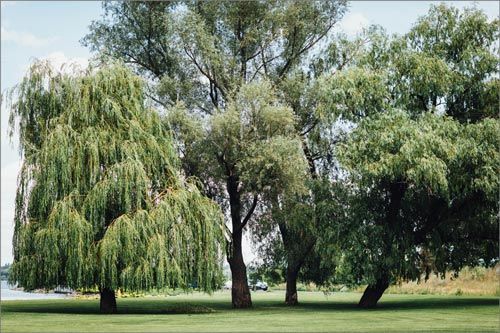



The crepe myrtle is a classic ornamental tree in that it displays showy blooms, attractive bark, and colorful fall foliage. Crepe myrtles come in three species - Queen's, Japanese, and Indica. The three are relatively similar and differ mostly in foliage size and bloom colors. All three tend to be hardy, drought-resistant trees that tolerate heat well.
While the beauty of crepe myrtle marks it as an ornamental tree, the wide canopy and dense foliage do mean it's a shade tree as well. When you're planning out your new landscaping and want to include a crepe myrtle, ensure your space can tolerate a tree up to 30 feet high and 25 feet wide. Once you have the location picked out, consider the following landscaping tips for around your crepe myrtle.
As noted, crepe myrtles will create shade. Therefore, if you're going to plant near the base of the tree, you'll need shade-tolerant plants. Hostas are an ideal choice. They're easy to maintain, and many species love the shade.
Hosta plants are known for their variegated leaves. The big, waxy leaves display stripes and patches of colors ranging from deep green to light yellow to pink and white. They can grow up to three feet tall, though some are as small as six inches. For width, they can range as far as eight feet. Choose an array of shade-loving hostas, and plant them around your crepe myrtle for texture and color.
If you're not sure your space can handle a 30-by-25-foot tree, look into some of the dwarf crepe myrtles under the Indica designation. Some of them even get classified as ornamental shrubs instead of trees. If you plant one of those, you could pair it with another ornamental shrub that's a little smaller but still attractive. Some ideal shrubs include the following:
Landscaping experts usually recommend pruning crepe myrtle trees in winter. If you're diligent about pruning your trees, you could utilize crepe myrtles to create a romantic shaded walkway. To create such an inviting path, you'll want to landscape around it, and use the crepe myrtles to slightly obscure what's ahead.
So, you'll start with a curved walkway of whatever paving material makes sense for your yard. The important aspect is it needs to curve so that the ending isn't clearly seen. Just beyond this curve is where you'll flank the walkway with paired crepe myrtles. Other bushy plants, such as Russian sage and ornamental grasses, should border the walkway leading to the trees.
You'll need to keep up on pruning your crepe myrtles to ensure they don't completely overgrow the walkway or start competing with each other's canopies. You want a little dappled shade and mystery at the far end of your walkway.
Crepe myrtle will drop some debris at times in the form of blooms and leaves, depending on the time of season. If you don't mind a little sweeping, some of the taller varieties of the trees, such as Japanese crepe myrtle, would be an ideal shade-giver for your patio. If you want a really shady patio, you could even plant a couple of trees.
The patio is usually close to the house. So, when planning where to plant your trees, make sure you account for the canopy width. You don't want to create a hazard between the branches and your roof. You'll also want to keep up on your pruning of that side of the tree.
Utilize the unique qualities of crepe myrtle to beautify your landscaping. Visit the experts at Ted's Trees, Ltd., for advice and the tree stock needed for your project.



